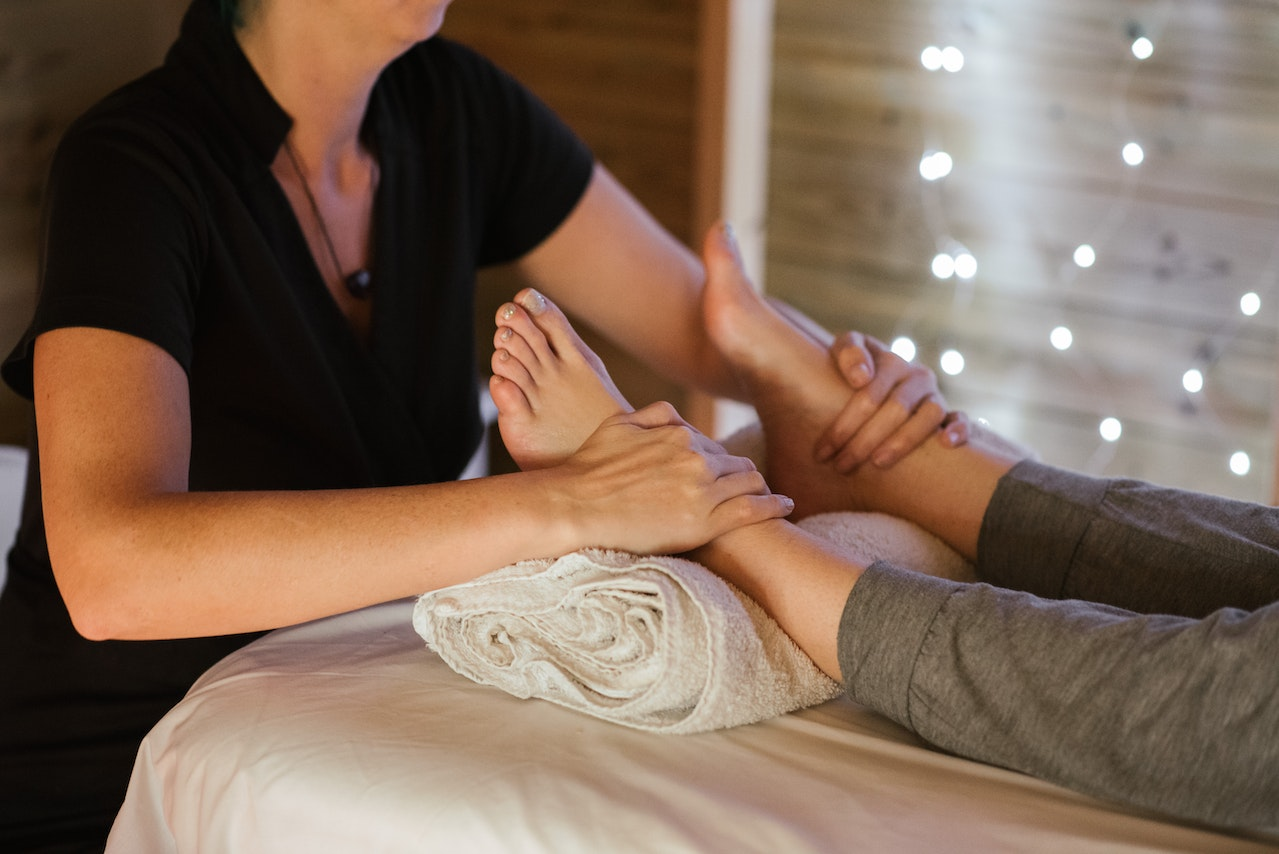Sedentary lifestyle is the norm for most people, nowadays. The daily sitting time for the average person is ten hours. Those who spend their days in a workplace may sit even more than the average person before heading home to unwind.
The negative impact arises when most people don't sit properly, contributing to the risks of sitting for long periods. Slouching positions, improperly adjusted chairs, and peripherals like misplaced keyboards and displays can all lead to discomfort and inefficiency at work.
Even though they have all the necessary ergonomic tools, many people experience pain at the end of a long workweek. What could be the issue if they have a good office chair, a correctly positioned display, and a keyboard tray at the right height? They may have already stepped on the solution: the ergonomic footrest.
Simply put, a footrest relieves pressure on the lower back, legs, and feet, making a perched or leaning position easier to tolerate. It can be a rail, low stool, etc.
This article will discuss the importance of footrests in the workplace, identify the types of people who benefit from using one and those who don't, and outline the steps necessary to make the most of an ergonomic footrest.
The Science Behind Footrests: Improving Circulation and Reducing Fatigue

Photo by Anete Lusina
You're probably reading this post while seated without a footrest. When you sit for prolonged amounts of time often, your legs don't get enough blood flow. When seated, the veins must exert greater effort to transport blood to the heart. As a result, you may experience various ankle problems such as ankle oedema, varicose veins, and possibly deep vein thrombosis (DVT).
Static posture, often known as "postural fixation," is a known risk factor for DVT. Micromotions of the soles, feet, and ankles promote venous return, diminish blood pooling, and reduce fatigue in the legs.
Fortunately, when the footrest is angled in a way that mimics the foot's natural position, it has been shown to improve blood flow. In a study of computer workers, the footrest position was strongly related to leg and ankle oedema. Researchers observed that oedema rose when slopes were too flat or too steep since less oxygenated blood reached the feet.
Each individual has a unique preference for the appropriate footrest angle. However, follow-up research found an inclined footrest between 15 and 30 degrees to enhance blood flow.
Also, additional research indicates the best posture for workers is a dynamic one in which they alternate between sitting, standing, leaning, and using a foot rail or footrest.
Pro tip: If you want to find the most comfortable position for your feet, get a footrest that you can tilt.
The Ergonomics Benefits of Footrest Under Desk
Maintaining a healthy desk posture has become increasingly crucial with the rise of online learning and remote jobs. Finding a desk height that is comfortable for you is the first step in making your workspace more ergonomic.
However, because adjustable desks can vary in height from one workplace to the next, one of the primary benefits of footrest under desk is allowing you to sit comfortably with your feet flat on the ground in any office.
Using ergonomic footrests can be an excellent method to lessen back discomfort and exhaustion from sitting at the computer all day. You can select a foot position that is comfortable thanks to adjustable heights and angles. You can also utilize your workplace footrest to support your feet while sitting upright, promoting good posture when working or chatting on the phone.
Alleviates Lower Back Pain

Photo by Karolina Grabowska
One of the lesser-known footrest health benefits is it’s good for lower back pain or discomfort while working.
The height of a movable office footrest is easy to change to help keep your feet, hips, knees, and spine in the right place while you work. This reduces stress on your lower back and improves blood flow.
Additionally, adjustable ergonomic footrests are available in various sizes and designs, allowing you to personalize them to suit your tastes. Whether you choose a height- or tilt-adjustable workstation, they are precisely what you must have to remain comfortable while seated.
Choosing the Right Ergonomic Footrest for Your Needs
Ergonomic footrests come in various forms, including the traditional foot flexor, foot bar, and tall foot flexor. Optimal solutions change based on user height, other ergonomic desk accessories, and seating preferences. Below are some other factors to consider when shopping for your next footrest.
-
Flexibility
People have varying heights. Therefore, consider getting a footrest that you can adjust in angle and height.
Adjusting the height of the Under Desk Foot Rest in this way ensures that your ankles are in a natural, comfortable position when seated. Therefore, they should not be constructed from weighty materials so you can move and clean them with relative ease.
-
Layout
Depending on the dimensions of your desk and chair, some footrests may be either tiny or too large for your comfort. Because of this, you need to select a sufficiently spacious pair to allow your leg to extend fully.
-
The Footrest's Size

Image by Clker-Free-Vector-Images from Pixabay
There is a wide range of footrest sizes, but typically they are between 17.28 and 18 inches long and 10 and 14.5 inches in width. In most cases, more room means greater flexibility; thus, bigger is better.
Your foot width and length are the primary factors to consider when selecting the right footrest size.
Also, you want to note how far apart your feet are when sitting comfortably. To avoid feeling cramped, a longer footrest may be preferable if it's on the spacious side.
-
Color
Before you purchase an ergonomic footrest, consider its aesthetics and functionality. The footrest's color should complement the office's primary color and relax and stimulate the user.
They should also complement the floor's color for extra visual appeal, particularly if you plan to buy an anti-slip floor mat.
-
Versatility
Everyone has a distinct idea of what it means to be comfortable. So, you should think about getting a seat that can be adjusted to fit your legs. This will promote proper alignment of the spine and stronger back muscles.
-
Footrest with Massaging Features
Massage balls are included with some footstools so that you can relax while massaging your feet. This quality is characteristic of footrests made of plastic.
These massage rollers ease foot pain, increase blood flow, and reduce stress.
In most cases, foam footrests are not equipped with these massaging spots. On the contrary, they typically take the shape of a dome, allowing you to flip it around and use it as a rocker for moving your feet back and forth.
As a result, you'll be more likely to move around, boosting blood flow to your legs.
-
Cost
You can purchase footrests for as little as $15.99 and as much as $311 or more on average. The price of a footrest generally depends on how well-made it is, how many features it has (like being able to adjust its height), and how big it is overall.
Choosing a low-priced under-footrest leg rest may mean sacrificing the unit's longevity, comfort, and quality.
It is important to assess not only the price and the length of the guarantee but also the manufacturer's reputation and the reviews of the product. These will help determine the dependability of any footrest you choose.
-
Durability
The durability of the footrest is something that you must consider. You don't want to waste your money on a cheap, fragile, sunken footrest that breaks down in less than a year.
There are instances when a footrest's price and durability are related.
If the price of the footrest that sits under your feet is relatively low, low-quality materials were likely utilized in its manufacture. Typically, these materials are lower quality than those in higher-priced ergonomic footrests.
They are also less inclined to be durable enough for prolonged, repeated use. In addition, their weight capacity is usually smaller.
-
Material

Image by JamesDeMers from Pixabay
There are several materials used to make footrests, including:
-
Leather
-
Foam
-
Plastic
The chosen material will determine how comfortable it feels to touch and how simple it is to maintain.
If you plan to use the footrest while wearing shoes, the texture of the fabric will be less of a factor in your experience.
However, a foam footrest will feel nicer and gentler to the touch than a plastic or leather footrest when you plan to use it barefoot or with socks.
In a perfect world, the cover for the footrest would have anti-microbial and anti-dust properties.
Pro Tip: People with cold feet should consider getting a heated footrest.
-
Aftercare
Always purchase your footrest from a trustworthy retailer with various warranty and aftercare options. This can involve timely delivery and reliable customer support.
If you want to avoid endlessly searching the internet for products with all these features and tick these boxes, check out the APOL premium footrest.
For all-day comfort, this APOL premium footrest aids in pressure point relief while offering circulation improvement. The layout encourages movement of the legs and feet during the workday, while individuals are often the least active.
It helps with non-intensive activities that burn calories, like typing, rocking your feet, or even pacing. Also, it encourages behaviors that boost the metabolic rate while maintaining general well-being.
It is the perfect size with enough compactness to fit beneath your desk, and you can tuck it away nicely when not in use. Even if you prefer to work while standing, you can still benefit from employing the rocking features of this footrest.
It weighs 0.20 kg and has dimensions of 45cm, 30.5 cm, and 15cm, and provides both pleasant and sturdy support. Because of this, this footrest is ideal for almost anyone to use in almost any kind of working setting.
Features
-
Encourages stretching and mobility
-
Modular, minimalistic style
-
Convertible rocking side
-
Plush, supportive, and comfy
Frequently Asked Questions about Footrests

Image by OpenClipart-Vectors from Pixabay
Why do high chairs need a footrest?
Maintaining a neutral spine alignment while sitting on a high chair all day is made easier with the help of a footrest. If you want to improve your ergonomic setup, putting a footrest in the space under your desk is a wonderful place to start.
The constant motion provided by a rocking footrest also helps to increase blood flow to the legs. You can recline further in your ergonomic chair thanks to the sloping design of the footrest, making it easier to reach out into its backrest. It will help you keep your back straight.
How can I choose the best ergonomic footrests for my office chair?
While seated at your desk, the ideal footrests for most workstations will encourage healthy posture and assist you in finding a neutral sitting position.
However, finding the right footrest might be difficult because most people must determine the factors to pinpoint. The under-desk footrests recommended above offer excellent options and are the best place to start your footrest journey.
What is the ideal height for a desk footrest?

Photo by Lauren Mancke on Unsplash
The standard range for their length is between 2 and 5 inches. The ideal height for a footrest allows you to relax with your feet propped up in a natural position. You should keep your body at wide angles and ensure that your legs are straight out ahead of you or somewhat bent downward.
Many people of different heights would benefit from using a footrest. For persons above the average height of 5'10, raise the footrest to accommodate your height. Also, you may get the right amount of comfort by extending the footrest in front of you.
How old do you have to be to use a footrest?
The APOL footrest's adjustable height is a significant benefit because it allows the product to grow with most young adults.
How should I clean my footrest?

Photo by Ben Garratt on Unsplash
If the footrest is dirty, clean it with a gentle detergent, and dry it with a paper towel or a delicate cloth. Avoid using any powerful cleaning products, like solvents.
Since your footrest come in direct contact with the sole of your shoes, it could become filled with sand or other material, making its adjustments challenging. Thus, cleaning the bracket of adjustable footrests before altering the height is recommended to prevent unwanted scratches, although the product's effectiveness doesn't change with any scratches.
Ready to put your tired feet to Rest?
Whether you work while sitting, standing, or a combination, a footrest can be a game-changer for your convenience, efficiency, and endurance. It increases mobility at the workplace and enhances your blood flow and ergonomic balance (or posture). This alleviates the soreness, weakness, exhaustion, stiffness, and discomfort brought on by inactivity and poor blood flow to the leg muscles.
Talk to our ergonomics specialists if you have any doubts about whether or not an ergonomic footrest might increase your comfort level at work. You ought to like your work, after all!


